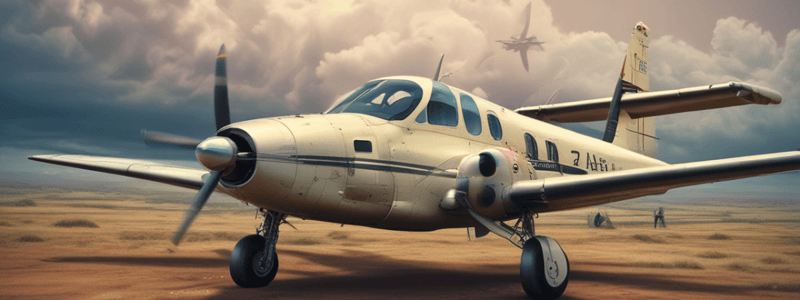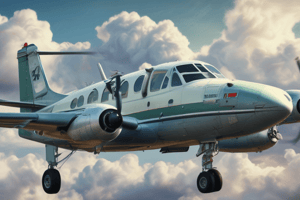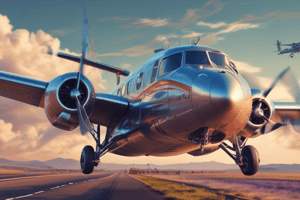Podcast
Questions and Answers
What is the primary function of Synthetic Vision Systems (SVS) in aviation?
What is the primary function of Synthetic Vision Systems (SVS) in aviation?
- To mimic external visual cues during flight
- To provide a physical view of the environment
- To assist in maintaining aircraft speed and altitude
- To create a computer-generated perspective based on known data (correct)
How do Enhanced Vision Systems (EVS) contribute to flight safety?
How do Enhanced Vision Systems (EVS) contribute to flight safety?
- By generating theoretical models of weather patterns
- Through sensor technology that provides a real-world view (correct)
- By visualizing navigational waypoints in digital format
- Through predictive analytics for weather assessment
What is one of the key benefits of using both SVS and EVS together?
What is one of the key benefits of using both SVS and EVS together?
- They create an abstract representation of air traffic
- They significantly reduce the cognitive workload of pilots (correct)
- They replicate the experience of flying in older aircraft
- They allow pilots to operate solely on computer-generated data
In what way do advanced vision systems improve pilots' situational awareness?
In what way do advanced vision systems improve pilots' situational awareness?
What challenge do SVS and EVS primarily address in aviation?
What challenge do SVS and EVS primarily address in aviation?
What is a potential future outcome of advancing vision system technology in aviation?
What is a potential future outcome of advancing vision system technology in aviation?
Which aspect is NOT enhanced by the integration of advanced vision systems?
Which aspect is NOT enhanced by the integration of advanced vision systems?
What role do runway lights and markings play in the decision-making process for pilots?
What role do runway lights and markings play in the decision-making process for pilots?
How do SVS and EVS complement each other in a cockpit environment?
How do SVS and EVS complement each other in a cockpit environment?
What impact do advanced vision systems have on accident rates in aviation?
What impact do advanced vision systems have on accident rates in aviation?
Synthetic Vision Systems (SVS) provide a real-world view through sensor technology.
Synthetic Vision Systems (SVS) provide a real-world view through sensor technology.
The combination of SVS and EVS can reduce cognitive workload for pilots.
The combination of SVS and EVS can reduce cognitive workload for pilots.
Both SVS and EVS are primarily designed to mitigate fuel consumption during flights.
Both SVS and EVS are primarily designed to mitigate fuel consumption during flights.
Advanced vision systems are ineffective in challenging visual environments.
Advanced vision systems are ineffective in challenging visual environments.
The integration of advanced vision systems in cockpits is expected to decrease the level of safety in aviation.
The integration of advanced vision systems in cockpits is expected to decrease the level of safety in aviation.
Enhanced Vision Systems (EVS) completely replace the need for conventional cockpit displays.
Enhanced Vision Systems (EVS) completely replace the need for conventional cockpit displays.
As technology evolves, advanced vision systems will likely become less sophisticated over time.
As technology evolves, advanced vision systems will likely become less sophisticated over time.
SVS can function independently of EVS without impacting the overall safety of the flight.
SVS can function independently of EVS without impacting the overall safety of the flight.
Real-time visual information provided by systems like SVS is irrelevant during unexpected weather changes.
Real-time visual information provided by systems like SVS is irrelevant during unexpected weather changes.
SVS provides a perspective based on historical data rather than known data.
SVS provides a perspective based on historical data rather than known data.
How do SVS and EVS improve pilots' decision-making during unexpected weather changes?
How do SVS and EVS improve pilots' decision-making during unexpected weather changes?
What is the effect of integrating SVS and EVS on cognitive workload for pilots?
What is the effect of integrating SVS and EVS on cognitive workload for pilots?
In what ways do SVS and EVS contribute to the overall safety margin for pilots?
In what ways do SVS and EVS contribute to the overall safety margin for pilots?
What potential advancements in technology could enhance the capabilities of SVS and EVS in the future?
What potential advancements in technology could enhance the capabilities of SVS and EVS in the future?
How do SVS and EVS mitigate the impact of visibility limitations on pilots?
How do SVS and EVS mitigate the impact of visibility limitations on pilots?
What role does real-time data play in the functionality of SVS and EVS during flight?
What role does real-time data play in the functionality of SVS and EVS during flight?
Discuss the future implications of advancing vision systems on accident rates in aviation.
Discuss the future implications of advancing vision systems on accident rates in aviation.
Why is the use of both SVS and EVS crucial instead of relying on one system alone?
Why is the use of both SVS and EVS crucial instead of relying on one system alone?
Explain the significance of runway lights and markings in conjunction with SVS and EVS.
Explain the significance of runway lights and markings in conjunction with SVS and EVS.
How do SVS and EVS assist pilots in hazardous situations beyond visibility issues?
How do SVS and EVS assist pilots in hazardous situations beyond visibility issues?
Flashcards are hidden until you start studying
Study Notes
Module Overview
- Focus on "Fundamentals of Aeromedical Factors" for commercial pilots.
- Module 3 emphasizes technological advancements in aviation safety.
- Introduction to Synthetic Vision Systems (SVS) as a revolutionary tool.
Synthetic Vision Systems (SVS)
- SVS enhances pilot situational awareness and navigation capabilities.
- Combines databases, algorithms, and sensors to create computer-generated imagery.
- Provides a detailed view of terrain, obstacles, and runways, particularly beneficial in low visibility and nighttime conditions.
- Visual display resembles a high-definition map, improving comprehension of surroundings.
- Integrates seamlessly with avionics, GPS, and Terrain Awareness and Warning Systems (TAWS).
- Represents a significant upgrade from traditional cockpit displays, akin to switching from black-and-white to 4K Ultra HD.
Advantages of SVS
- Helps pilots navigate through poor visibility by overlaying realistic visual data.
- Invaluable during critical flight phases such as takeoffs and landings.
- Acts as a safety barrier against controlled flight into terrain (CFIT) and loss of situational awareness.
Future of SVS and Enhanced Vision Systems (EVS)
- Expected advancements in visual accuracy, database quality, and possible integration with augmented reality.
- EVS employs sensors like infrared cameras to provide real-time images on displays, improving visibility in adverse conditions like fog and haze.
- EVS enhances decision-making and situational awareness during critical flight phases.
Regulations and Pilot Training
- EVS must undergo stringent certification tests to ensure safety standards.
- Pilots require training to effectively interpret information from EVS systems.
Summary of Key Points
- SVS and EVS enhance safety and efficiency in flight operations.
- Both systems complement each other, improving navigation and reducing cognitive workload.
- Continuous evolution in technology will lead to further enhancements in aviation safety systems.
Fundamental Concepts of Aeromedical Factors
- Module 3 emphasizes technological advancements enhancing aviation safety and efficiency for aspiring commercial pilots.
- Previous modules covered medical certification, hypoxia, medication usage, and stress management.
Synthetic Vision Systems (SVS)
- SVS significantly improves pilots' situational awareness and navigation capabilities, especially in challenging environments.
- Utilizes sensors, databases, and algorithms to overlay a realistic computer-generated image of terrain and obstacles.
- Enhances visibility during poor conditions, effectively allowing pilots to "see" through fog and darkness.
- Features a 3D map that renders environmental elements in an intuitive visual format, improving understanding and navigation.
- Integrates seamlessly with avionics systems like GPS and Terrain Awareness and Warning Systems, creating a comprehensive navigational tool.
- Compared to traditional displays, SVS provides a more vivid and accurate depiction akin to 4K Ultra HD.
- Already in use in commercial aviation, SVS aids during critical flight phases such as takeoffs and landings.
- Future advancements may include enhanced visuals and direct integration with augmented reality technologies.
Enhanced Vision Systems (EVS)
- EVS is a cutting-edge technology that improves visibility in low-light or low-visibility conditions, acting as a force multiplier for situational awareness.
- Utilizes sensors and infrared or millimeter-wave cameras to deliver high-definition imagery of the aircraft's surroundings.
- Allows pilots to navigate confidently in problematic conditions, providing clearer visual cues for decision-making.
- Plays a crucial role in critical phases of flight by improving situational awareness during takeoff, landing, and taxiing.
- Helps mitigate risks associated with poor visibility, supporting better obstacle and terrain awareness.
- Regulatory comprehension is important for pilots, as EVS supplements situational awareness without replacing traditional navigation aids.
Comparison and Integration of SVS and EVS
- SVS and EVS complement each other by providing different perspectives: SVS generates data-driven information, while EVS delivers real-time visuals.
- SVS displays three-dimensional terrain and obstacle renderings, crucial during mountainous or low-visibility approaches.
- EVS captures real-time environmental images, enhancing vision in fog or during nighttime operations.
- Both systems contribute to reducing cognitive workload and increasing flight safety by enhancing pilots' decision-making capabilities.
Summary and Future Outlook
- The combination of SVS and EVS represents a significant shift in cockpit technology, enhancing situational awareness and overall flight safety.
- Ongoing technological evolution promises further advancements in these systems, potentially lowering accident rates related to visibility challenges.
Module Overview
- Focus on "Fundamentals of Aeromedical Factors" for commercial pilots.
- Module 3 emphasizes technological advancements in aviation safety.
- Introduction to Synthetic Vision Systems (SVS) as a revolutionary tool.
Synthetic Vision Systems (SVS)
- SVS enhances pilot situational awareness and navigation capabilities.
- Combines databases, algorithms, and sensors to create computer-generated imagery.
- Provides a detailed view of terrain, obstacles, and runways, particularly beneficial in low visibility and nighttime conditions.
- Visual display resembles a high-definition map, improving comprehension of surroundings.
- Integrates seamlessly with avionics, GPS, and Terrain Awareness and Warning Systems (TAWS).
- Represents a significant upgrade from traditional cockpit displays, akin to switching from black-and-white to 4K Ultra HD.
Advantages of SVS
- Helps pilots navigate through poor visibility by overlaying realistic visual data.
- Invaluable during critical flight phases such as takeoffs and landings.
- Acts as a safety barrier against controlled flight into terrain (CFIT) and loss of situational awareness.
Future of SVS and Enhanced Vision Systems (EVS)
- Expected advancements in visual accuracy, database quality, and possible integration with augmented reality.
- EVS employs sensors like infrared cameras to provide real-time images on displays, improving visibility in adverse conditions like fog and haze.
- EVS enhances decision-making and situational awareness during critical flight phases.
Regulations and Pilot Training
- EVS must undergo stringent certification tests to ensure safety standards.
- Pilots require training to effectively interpret information from EVS systems.
Summary of Key Points
- SVS and EVS enhance safety and efficiency in flight operations.
- Both systems complement each other, improving navigation and reducing cognitive workload.
- Continuous evolution in technology will lead to further enhancements in aviation safety systems.
Studying That Suits You
Use AI to generate personalized quizzes and flashcards to suit your learning preferences.




